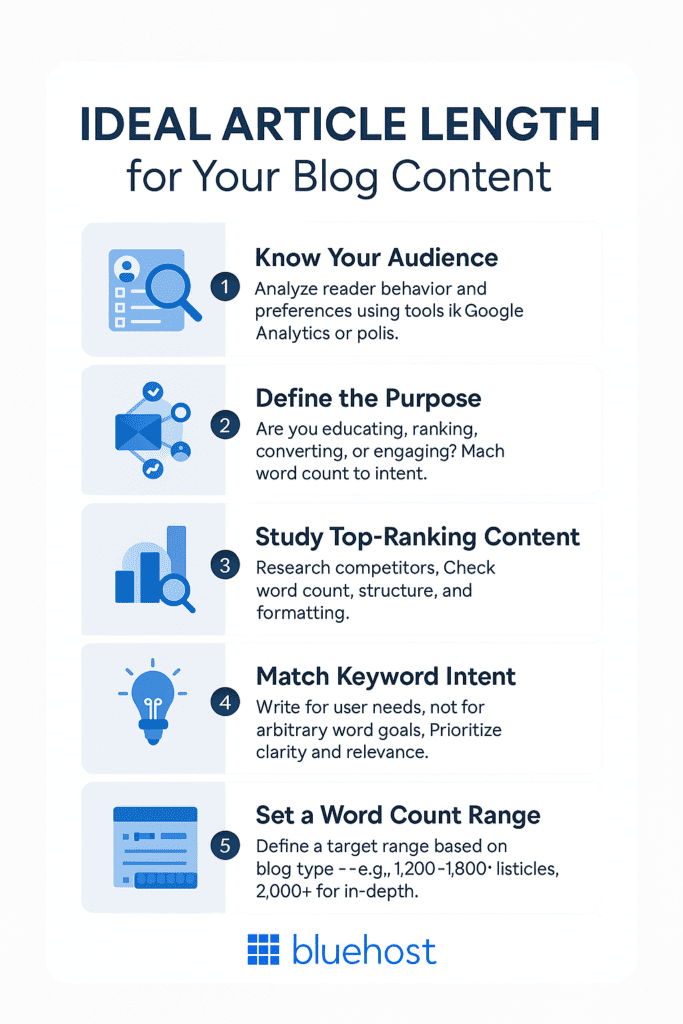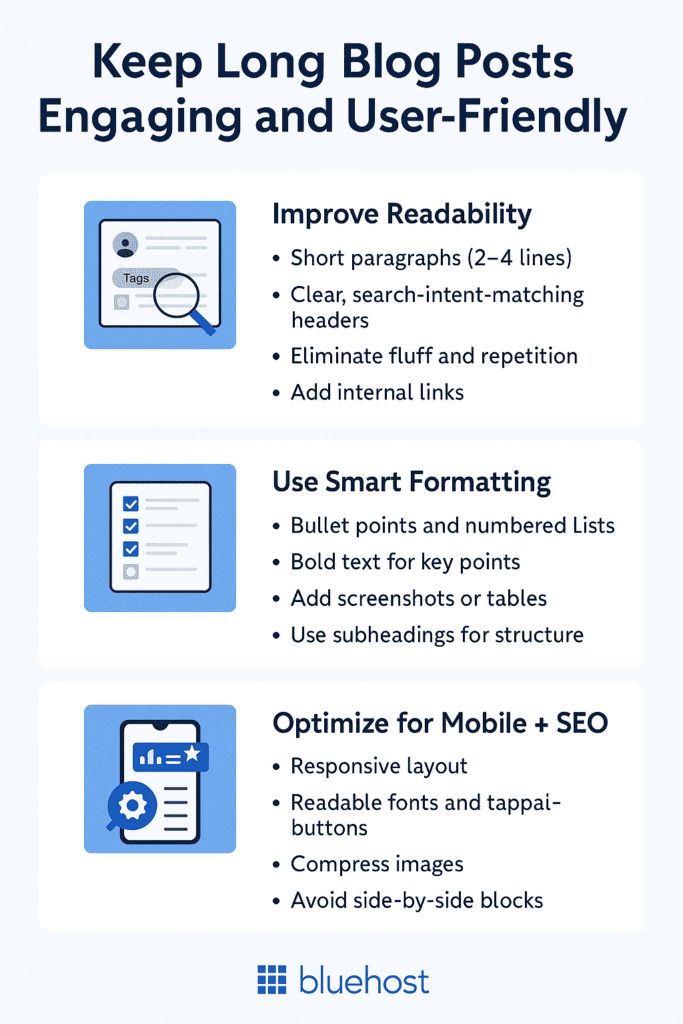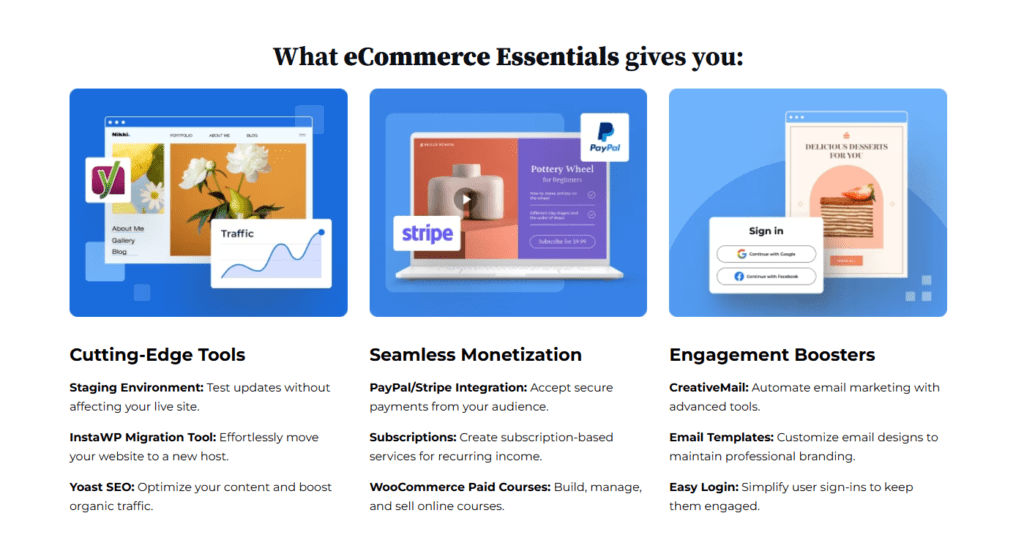Key highlights
- Understand the ideal blog post length based on your goals, audience and content type to improve SEO and engagement.
- Learn how long-form blog posts perform better by increasing dwell time, keyword depth and search engine visibility.
- Explore optimal blog word counts by goal, such as ranking on Google, earning shares or generating leads.
- Discover the ideal length for different blog types, including tutorials, listicles, case studies and product reviews.
- Follow a proven 5-step strategy to choose the right content length and match your blog to user intent and search demand.
If you’ve ever finished writing a blog and wondered, “Is this long enough to show up on Google?”, you’re not alone. It’s one of the most debated questions in content marketing today. Writers, marketers and SEO pros all want to know: What’s the magic word count for better visibility, more engagement and lasting SEO impact?
Here’s the truth: in 2025, Google doesn’t reward length for length’s sake. Instead, it favors well-structured content that answers search intent with clarity, depth and real value. According to the study by Backlinko, the average blog post length of a top-ranking blog post is 1447, making depth a clear ranking factor.
So yes, longer blog posts perform better when they offer high-quality content aligned with your readers’ needs. This guide explores the best blog post length for ranking in 2025 based on goal and blog type.
What is the optimal blog word count for your content goals?
There’s no one-size-fits-all answer for the ideal blog post length. Your best word count depends on what you want the content to achieve.
| Content goal | Optimal word count | Purpose |
| Rank on Google | 1,500–2,500 words | Improves keyword depth and visibility in search engines |
| Get social shares | 1,000–1,800 words | Easy to read, encourages sharing on social platforms |
| Generate leads | 1,200–1,600 words | Builds trust and supports clear calls to action |
| Grow email list | 1,000–1,500 words | Establishes authority and promotes newsletter signups |
| Quick answers | 600–900 words | Ideal for FAQs, quick tips or targeting featured snippets |
| Pillar content | 2,500+ words | Covers topics in depth for SEO and internal linking |
Let’s break it down by goal.
1. Blog post length to rank well on Google
If your main goal is to rank higher in Google’s search results, the best blog post length should be between 1,500 to 2,500 words. That range gives enough space to provide in-depth guides, optimize for multiple keywords and include relevant internal links.
This is the typical average word count found in the top 10 search results, especially for long-form blog posts targeting competitive terms.
2. Ideal blog post length for social shares
For maximum sharing, keep your blog post between 1,000 and 1,800 words. This format works well for listicles and quick answer content. Readers are more likely to share posts that are useful, easy to skim and not overwhelming. This range also works for food blogs, trend posts or posts offering how-to guides and tips.
3. Word count for lead generation and conversions
This long-form blog strategy is ideal for building trust and prompting conversions. If you’re focused on generating leads, a good blog post would typically consist of content between 1,200 and 1,600 words. This gives you space to build value, explain your offer and include clear CTAs, all while holding attention. Short blog posts might leave questions unanswered, while overly long ones can overwhelm readers before they’re ready to engage or take action.
4. Blog post length for email list growth
For email signups, stick to 1,000 – 1,500 words. You want enough content length to establish trust and provide value. Incorporate lead magnets, newsletters and strategically placed opt-in prompts and calls-to-action throughout your content to boost conversions. This blog-length guide format works especially well for content marketing, coaches and online businesses trying to grow their lists.
What is the ideal blog post length for SEO?
The length of a blog post affects how well it performs in search engine results. But it’s not just about more word count, it’s about meeting user intent.
| Type of blog post | Ideal length for SEO |
| Short blog posts | 300 – 600 words |
| Standard blog posts | 700 – 1,000 words |
| In-depth blog posts | 1200+ words |
Let’s break it down.
Does blog post length directly affect rankings?
Yes. Longer blog posts perform better in most cases, especially when they offer informative content and match what people are searching for. Search engines prioritize content that offers depth and aligns with search intent. Google’s search results often rank posts with more detailed explanations and internal links. A longer post gives you room to target more keywords, answer more questions and include supporting data.
How does word count impact user engagement and backlinks?
Long-form content increases dwell time, which tells search engines that users find your blog content valuable and worth reading. Dwell time refers to how long a user stays on your blog before clicking away. The average length of the top-ranking blog posts is typically between 1,447 to 2400 words. Long-form blog posts also attract more backlinks than short-form content. That’s because longer articles are more likely to be referenced as sources in other blogs, articles and industry guides.
What’s more important, quality or word count?
Both. You need enough content length to satisfy the reader, but it has to be high-quality content, not just filler. Avoid thin content that’s overly short or vague. However, don’t stretch your post unnecessarily; that can lead to a bad experience. Instead, focus on writing great blog posts that deliver clear answers, use supporting details and match your target audience’s expectations.
Also read: How to Audit Your Blog and Improve Content Performance
How long should different types of blog posts be?
Every blog post serves a different purpose, so the ideal blog post length depends on the type of content you’re creating.
| Blog type | Ideal word count | Why it works |
| How-to tutorials | 1,800+ words | Allows step-by-step detail, deeper value and more internal links |
| Listicles & roundups | 1,000–1,800 words | Easy to skim, shareable, optimized for reader engagement |
| Case studies & in-depth posts | 2,000+ words | Builds authority, supports backlinks, ideal for SEO-rich content |
| Product reviews & comparisons | 1,000–1,800 words | Great for buyer keywords, concise yet complete |
Here’s a breakdown by format.
1. How-to tutorials: Go in-depth with 1,800+ words
How-to guides typically need 1,800 words or more to explain steps fully, provide context and offer a complete answer. This length is ideal for long-form content, especially when teaching processes or guiding readers through multiple stages. It also gives you space for internal links, screenshots or bonus tips that build high-quality content and improve SEO ranking.
2. Listicles and roundup articles: 1,000–1,800 words
List-style blog posts perform best between 1,000 and 1,800 words. They’re swimmable, engaging and highly shareable across platforms. This post length works well for content marketing, trending topics and industry roundups with strong user intent. Make each point meaningful to avoid thin content and boost time-on-page.
3. Case studies and in-depth content: 2,000+ words
When writing case studies or original research, go long. Aim for 2,000 words or more to present data, insights and takeaways. These longer blog posts support professional journalism standards and perform well in competitive search engine results. They also increase backlinks, authority and user trust, especially when cited by top-ranking posts.
4. Product reviews and comparisons: 1,000–1,800 words
Product reviews and comparison blogs work best in the 1,000 to 1,800 word range. This gives you space for pros, cons, features and recommendations. This format balances depth with simplicity. It’s ideal for targeting buyer intent and attracting more traffic to your own blog.
How to determine the ideal article length for your content?
Finding the ideal blog post length is about more than picking a number. You need to combine data, intent and purpose to create something worth reading and ranking.

Here’s a five-step process to help you choose the optimal blog word count for your next blog post.
Step 1: Know your audience and their reading habits
Start by understanding who you’re writing for. A busy professional might prefer a quick answer, while a niche expert may expect long-form content. If your target audience is researching deeply or making a purchase decision, they’ll likely stay longer on the blog posts.
Moreover, use tools like Google Analytics or social media polls to learn how long your readers engage with your blog content.
Step 2: Identify the purpose of the blog
Ask yourself what the blog post is meant to do. Are you educating? Ranking for a competitive keyword? Driving sign-ups? If you’re aiming to generate discussion or build authority, you’ll need a long-form post with clear internal links and value-packed sections. If you’re writing for clicks or shares, a shorter format with bold headlines and punchy insights might work better.
Step 3: Study the top-ranking content (your SERP competitors)
Search your focus keyword and review the top-ranking posts in the search engine results. Check the average word count, structure and readability of those pages. Are they using visuals, how-to guides or list formats? This step gives you real-world examples of what Google already sees as the ideal article length for that topic.
Step 4: Align with keyword intent, not just word count
Avoid adding unnecessary words just to reach a specific word count. Instead, prioritize user intent, focus on what the reader is genuinely looking to understand or accomplish when they perform a search.
For example, a search like “how many words should a blog post be?” demands facts, not fluff. A high-quality content match matters more than padding. If you meet the need quickly and clearly, your content will perform even if it’s shorter.
Step 5: Choose your minimum and maximum range
Once you understand the purpose and intent, set a target blog length. Define a minimum and maximum word count range.
For example, you might aim for 1,200 to 1,800 words for listicles or 2,000+ words for pillar pages. This keeps your writing focused while giving room for depth, internal links and useful visuals. The result is content that ranks and delivers.
Use Bluehost + Yoast SEO to choose the right blog length, optimize each section and increase your content’s visibility.
What are the pros and cons of long-form blog posts?
Long-form blog posts often perform better in search engine results, especially if they provide helpful content but they’re not perfect for every situation. Let’s look at the upsides and potential challenges.
Benefits of long-form content:
- Improves SEO and keyword coverage: Longer blog posts allow you to target multiple related keywords and expand your SEO analysis. You can also include more internal links, improve visibility and align with blog post length SEO best practices that favor in-depth, useful content.
- Encourages dwell time and shares: When done right, loFng-form content keeps readers on the page longer. This increased dwell time signals to search engines that your content is helpful. It also boosts the chance of earning organic traffic from shares.
- Builds topic authority: In-depth content establishes your blog as a go-to resource. It’s ideal for pillar pages, in-depth guides or anything designed to build topic authority in a competitive space.
Drawbacks to watch out for:
- Time-intensive to write and edit: Creating a strong long-form post takes time. Research, writing and polishing can easily double the effort compared to shorter blog posts.
- May reduce mobile engagement: Mobile users may prefer shorter articles. If your post isn’t well-formatted or scannable, you risk losing readers before they finish.
- Can dilute focus if not well-structured: Too much content without a clear structure becomes overwhelming. High-quality content still needs clarity, especially if you’re writing longer articles with a broad scope.
Knowing when to use long-form content and how to structure it effectively is key to making it work for your blog.
How can you keep long blog posts engaging and user-friendly?
Long-form content can boost SEO and drive more organic traffic, but it needs to be clear and helpful to keep readers from bouncing. Here’s how to do that.

1. Improve readability for long content
Start with short paragraphs, aiming for 2–4 lines each. Use clear headers that match search intent and signal the topic of each section. Add internal links to guide users deeper into your own blog.
Write in a tone that matches your target audience and avoid fluffing. High-quality content speaks directly to the reader’s needs. Keep sentence length under control and remove repetition to maintain a smooth flow throughout the post.
2. Use formatting tricks to help readers stay engaged
Use bullet points, numbered lists, bold text and subheadings. These make your content scannable and easier to digest. To support informative content, add visuals like screenshots, tables or quick summaries. When possible, break up heavy text blocks with images. Writing long-form content doesn’t mean writing long paragraphs; structure helps people stay on the page.
3. Optimize the layout for mobile and SEO
Use a responsive layout that adjusts for screen size. Most search engines prioritize mobile-first design, especially Google’s search results. Choose a readable font and make sure CTAs, links and buttons are easy to tap.
Avoid side-by-side elements that break on mobile. Don’t forget to compress images and improve loading speed. These factors help your longer blog posts perform better in rankings.
How Bluehost helps you start, scale and monetize your blog?
Building a successful blog takes more than writing alone. With Bluehost eCommerce Essentials, you get everything needed to launch, grow and turn your blog into a profitable business.

1. Start with essential tools for beginners
Getting started is easy with Bluehost. We provide all the core features you need to build a secure, fast and reliable blog. From your domain to storage, every essential is covered, so you can focus on content.
- Free domain for the first year.
- Free SSL certificate from Let’s Encrypt to secure your site.
- Free WordPress Migration Tool with zero downtime during the transfer.
- NVMe storage for faster loading times and better performance, even on high-traffic days.
2. Scale with managed tools and smart automation
As your blog grows, so do your needs. Bluehost helps you manage updates, drive traffic and engage your audience effortlessly. Our tools are designed to save time and streamline your workflow.
- Managed WordPress and PHP updates to keep your site secure and running smoothly.
- Yoast SEO integration to optimize every blog post for better visibility and organic traffic.
- CreativeMail by Constant Contact to automate email campaigns and grow your subscriber list.
- Custom email templates to maintain consistent branding across communications.

3. Monetize with eCommerce-ready features
When you’re ready to earn from your blog, Bluehost gives you flexible tools to start selling and generating revenue. Whether you offer products or services, our platform supports your growth.
- Sell physical or digital products directly from your blog.
- Offer downloads or build a membership site for exclusive content.
- Set up subscription-based services for recurring revenue.
- 30-day money-back guarantee so you can try Bluehost risk-free.
Final thoughts
There’s no perfect word count for every blog post but getting the length right can boost SEO and keep readers engaged. Whether you’re writing long-form blog posts, how-to guides or quick answers, your goal is the same: deliver high-quality content that meets user intent.
The real secret to the ideal blog post length is understanding what your audience wants and building content around that.
At Bluehost, we help you create content that performs. From WordPress hosting and Yoast SEO to eCommerce Essentials and CreativeMail, we offer everything you need to grow. If you’re ready to publish content that ranks, converts and brings in organic traffic, we’ve got you covered.
Ready to grow your traffic in 2025? Start with Bluehost WordPress Hosting, optimize content with Yoast and build smarter blogs with eCommerce Essentials. Get started now
FAQs about blog post length
Yes, short blog posts can still rank if they clearly answer the query and match the user intent, but many factors influence their success. However, they often struggle to compete with long-form content that includes more depth, internal links and relevant keywords.
In 2025, the ideal article length for most SEO-focused content ranges from 1,500 to 2,500 words. This range allows space for high-quality content, keyword optimization and a strong content strategy that aligns with search engines.
No, Google doesn’t set a word count rule. But thin content that lacks depth often performs poorly. Focus on delivering value, not just hitting a number.
Yes, if the content is outdated or doesn’t fully satisfy the user’s intent, it’s smart to expand and improve it. Writing longer blog posts can help boost rankings, reduce bounce rate and improve visibility in Google’s search results.
Long-form posts often rank well in search results and provide comprehensive value. However, user engagement also depends on content relevance, clarity and addressing readers’ needs.



Write A Comment